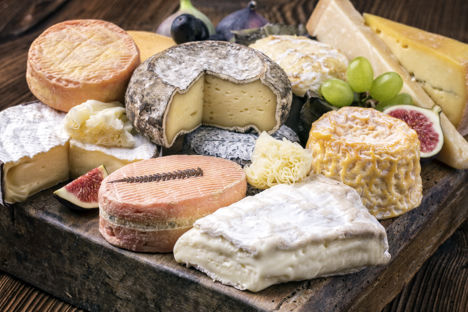
How to present a cheeseboard
There are countless articles analysing which cheeses to buy for your cheeseboard, but how do you go about making it look as good as it tastes? We talked to food journalist and cheese writer Patrick McGuigan to find out.
How to present a cheeseboard
There are countless articles analysing which cheeses to buy for your cheeseboard, but how do you go about making it look as good as it tastes? We talked to food journalist and cheese writer Patrick McGuigan to find out.
Make sure your voice is heard in this year's Great British Cheese Awards and vote now!
Should you have a cheddar and a Cheshire on the cheeseboard? Do certain blues go with certain softs? Are there rules regarding the ratio of cracker varieties to the number of washed-rinds and territorials, and which should be served together? In short, no – the best thing about putting together a cheeseboard is that there are no rules. If you want nothing but soft cheeses, go for it. If you find Stilton too strong, don’t feel pressured to buy one just because it’s Christmas. But if you’re wondering how to make your board look as good as it possibly can, there are one or two guidelines you can follow.
Patrick McGuigan has been judging cheese competitions for years (including our own Great British Cheese Awards), and knows what goes into a good looking cheeseboard. ‘I tend to have around four pieces of cheese (a hard, a blue, a sheep’s milk and a stinky washed-rind) or just one huge one surrounded by an array of condiments,’ he says. ‘It’s tempting to go for lots of different cheeses, but this means buying smaller wedges that’ll end up drying out very quickly.
‘Basically, you’re trying to hit as many textures, flavours, milk types, colours and shapes as you can without having to buy more than four cheeses,’ adds Patrick. ‘Think about shapes and colours – you don’t want all your cheeses to be yellow or white. There are quite a few pyramid-shaped cheeses nowadays that are rolled in ash, which look really good and add height to the board. These are also good because you’re buying the whole cheese, rather than just a slice or wedge, so they have a lot more presence on the table.’
Despite all the choice in British cheese shops today, Patrick says one way to instantly give your cheeseboard gravitas is to pick just one. ‘It might sound a bit controversial, but I really think having one whacking big bit of cheese on the table makes a real statement – a kilogram of something always looks great. This also means you can go to town on the condiments: a pot of honey, some homemade peanut brittle, a few slices of fruit cake, all sorts of different chutneys and pickles, whatever you like. It always creates a talking point and seems to get people excited. Just make sure all your guests are going to like the cheese you picked, otherwise you’re in trouble.’
Whatever cheeses you choose, make sure they’re in peak condition before you eat them. ‘Cheeses benefit from being left out at least an hour before serving because they open up and taste a lot better,’ explains Patrick. ‘Just watch them after a few hours because the rind can start to dry out a bit. Cover them with wax paper, which will allow them to breathe but stay at their very best.’
Patrick McGuigan
On board
Cheeses chosen? Good – now it’s time to think about how they’ll be presented. ‘When it comes to the actual cheeseboard itself, I don’t think you can beat wood,’ says Patrick. ‘Slate looks great because the colours contrasts so well with the white and yellow cheeses, but I think it feels a bit naff these days – perhaps because some restaurants have made a habit of serving food on slate when they shouldn’t be! The shape of the board makes the most difference; instead of a square or rectangle, I like to get one of those long paddles with a handle. You can arrange the cheeses in a line and, if it isn’t too heavy, pass it around. I also have a really thick chopping board, almost like a butcher’s block. When you put a load of cheese on that it’s quite high and almost acts like a podium for the cheese, which looks great.’
A traditional cheeseboard will have the cheeses sitting side by side, ready for guests to cut into. But you can have fun arranging the cheeses as they are brought to the table as well. ‘I judge a cheese shop competition every year and get a lot of inspiration from there,’ says Patrick. ‘If you go into a cheesemonger like Neal’s Yard Dairy or Paxton & Whitfield you can pick up some great ideas. For instance, if you have a nice triangular wedge of something put it rind-side down so the point is sticking up in the air, or if you have a few wheels of soft cheese stack them on top of one another. The bigger your chunks of cheese, the easier it is to start playing around with how they sit on the board.’ Once you’re happy with the way they look, add your pots of chutney, crackers and any other condiments, and you’ll be the proud owner of a beautiful looking cheeseboard. After that, all that’s left to do is devour it.


